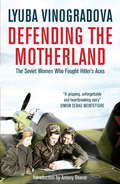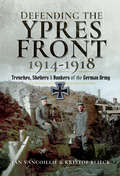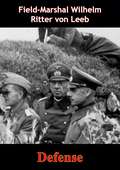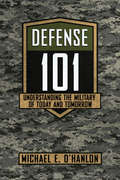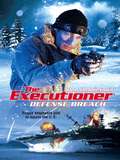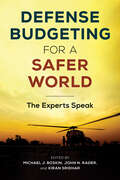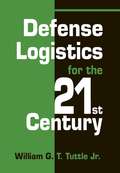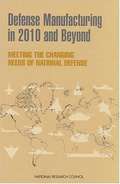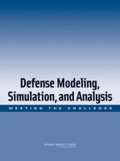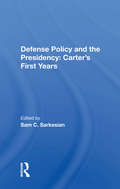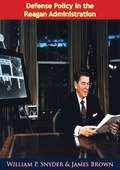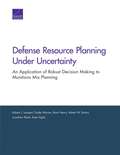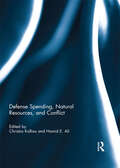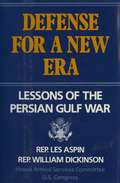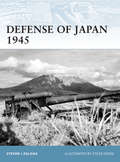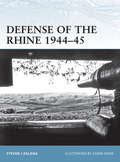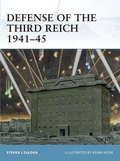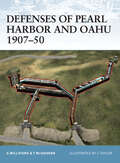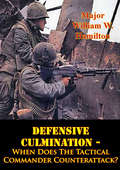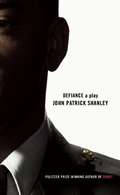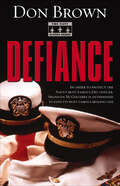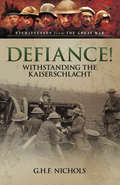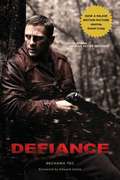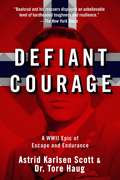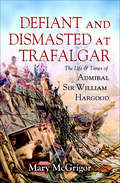- Table View
- List View
Defending the Motherland: The Soviet Women Who Fought Hitler's Aces
by Lyuba VinogradovaPlucked from every background, and led by an N.K.V.D. Major, the new recruits who boarded a train in Moscow on 16th October 1941 to go to war had much in common with millions of others across the world. What made the 586th Fighter Regiment, the 587th Heavy-bomber Regiment and the 588th Regiment of light night-bombers unique was their gender: the Soviet Union was creating the first all-female active combat units in modern history.Drawing on original interviews with surviving airwomen, Lyuba Vinogradova weaves together the untold stories of the female Soviet fighter pilots of the Second World War. From that first train journey to the last tragic disappearance, Vinogradova's panoramic account of these women's lives follows them from society balls to unmarked graves, from landmark victories to the horrors of Stalingrad. Battling not just fearsome Aces of the Luftwaffe but also patronising prejudice from their own leaders, women such as Lilya Litvyak and Ekaterina Budanova are brought to life by the diaries and recollections of those who knew them, and who watched them live, love, fight and die.
Defending the Ypres Front, 1914–1918: Trenches, Shelters & Bunkers of the German Army
by Jan Vancoillie Kristof BlieckPublished by the Memorial Museum Passchendaele in 2016 in Dutch as Bouwen aan het front, this book examines how the German army developed field fortifications to hold what can loosely be described as the Ypres Front. With the decision by Falkenhayn in 1915 to concentrate Germanys offensive efforts largely in the east, the German defenders around Ypres set to developing their lines for semi-permanent occupation. The sub soil around the Salient generally made it difficult to construct and maintain mined (i.e. deep) dugouts—unlike on, for example the Somme, with easily worked chalk not far below the surface. The only practicable alternative was to use reinforced concrete.In this book the authors (both with many years of experience in researching and working on matters Great War, particularly the German army in Belgium) have examined in detail an impressive range of primary sources to provide a narrative of what the Germans built, how they built it (the logistical challenge was enormous) and how the designs and requirements of bunkers (for example, forward medical bunkers, artillery shelters, machine gun and observation bunkers) changed as the war progressed and as the military situation on the front dictated. There are many photographs, largely unseen by British readers, design diagrams and maps to supplement the text; whilst the activities of selected particular formations are examined in detail to provide an example of the effort that was put into the work.Additions to the Dutch edition will include a tours section, taking a visitor to accessible remaining structures in the Salient area; and a glossary of terms and their English equivalent. The book will be in full color throughout.
Defense
by Field-Marshal Wilhelm Ritter von Leeb"THE principles of conduct of war and conduct of combat as expounded in this book by Field Marshal General Ritter Wilhelm von Leeb were written only a few years before the present war."Von Leeb realistically and meticulously examined and re-examined the existing conceptions of defense to analyze what of value remained from World War I. He originally published his theories in the Militärwissenschaftliche Rundschau ("The Scientific Military Review") of the German War Office. They were later issued in book form, under the title Die Abwehr, in Berlin in 1938, and appear for the first time in English translation in this work."In his DEFENSE von Leeb, as a military thinker and scientist, comparable to any of the outstanding authorities of the old German army--Schlieffen, Falkenhayn, Groner, Seeckt, etc.--offered his government a plan for the next war in which Germany might be engaged. It is estimated by competent judges as probably "the most important piece of research in the field of strategy and tactics in modern warfare that has appeared in a decade.""
Defense 101: Understanding the Military of Today and Tomorrow
by Michael E. O'HanlonIn Defense 101, a concise primer for understanding the United States' $700+ billion defense budget and rapidly changing military technologies, Michael O'Hanlon provides a deeply informed yet accessible analysis of American military power.After an introduction in which O'Hanlon surveys today's international security environment, provides a brief sketch of the history of the US military, its command structure, the organization of its three million personnel, and a review of its domestic basing and global reach, Defense 101 provides in-depth coverage of four critical areas in military affairs: • Defense Budgeting and Resource Allocation: detailed budget and cost breakdowns, wartime spending allocations, economics of overseas basing, military readiness, and defense budgeting versus US grand strategy• Gaming and Modeling Combat: wargaming, micro modeling, nuclear exchange calculations, China scenarios, and assessments of counterinsurgency missions• Technological Change and Military Innovation: use of computers, communications, and robotics, cutting-edge developments in projectiles and propulsion systems• The Science of War, military uses of space, missile defense, and nuclear weapons, testing, and proliferationFor policy makers and experts, military professionals, students, and citizens alike, Defense 101 helps make sense of the US Department of Defense, the basics of war and the future of armed conflict, and the most important characteristics of the American military.
Defense Breach
by Don PendletonAll bets are offA group of insiders has stolen a top-secret code that could compromise the entire U. S. defense system. Mack Bolan is called upon to track the security breach, only to discover he's too late. With half of the code now in the possession of a radical terrorist group, the stakes have suddenly been raised and U. S. aircraft carriers are sitting ducks in the Persian Gulf. The terrorists have joined forces with a Las Vegas crime family, and Bolan must infiltrate the Mob to stop the final transaction. As the Middle East edges closer to war, the Executioner has no choice but to unleash a battle of his own.
Defense Budgeting for a Safer World: The Experts Speak
by Michael J. Boskin, John N. Rader, and Kiran SridharAmerica is facing the most dangerous and complex geopolitical environment since World War II. Ensuring the adequacy and flexibility of our defense budget is essential to keeping our nation secure and the world safe for global democracy. Defense Budgeting for a Safer World brings together the ideas, perspectives, and solutions of America's most renowned experts on national security and the defense budget.The volume originates from a conference held at the Hoover Institution in early 2023 and reflects the presentations, discussions, and debates among military and civilian leaders. Drawing on their remarkable experience leading the Pentagon, the services, Congress, and academe, these experts lay out the key priorities in reforming, realigning, and rightsizing the budget amid current challenges. Several topics converge: national security threats, strategy, technology and innovation, personnel, reform options, and the politics of the defense budget. This unique compilation covers each of the major areas of debate in forging and sustaining a defense budget capable of supporting the nation's security needs.
Defense Logistics for the 21st Century
by William Tuttle Jr.The last comprehensive study of defense logistics was published in 1959. In the ensuing forty-five years a revolutionary change in information technology and defense strategy has swept the field and mandated a new understanding of the objectives and principles of military logistics. The author, renowned defense logistics expert General William Tuttle, covers all aspects of the subject including force projection, force sustainment, and minimizing the logistics "footprint" in battle spaces. Within these objectives, he includes five principles that are employed to assess the effectiveness of the process and identifies their shortfalls and remedies. He also illuminates the major influences of culture and politics on defense logistics and proposes ways to minimize their adverse impact on combat readiness. Written for defense logistics leaders - those currently coping with the challenges and those logistics aspiring to lead - and for everyone involved in the complexities of planning and strategy, this up-to-date volume is sure to become a hallmark in the field.
Defense Manufacturing in 2010 and Beyond: Meeting the Changing Needs of National Defense
by National Research CouncilThe end of the Cold War, the evolving mission of the U.S. Armed Services, the dramatic improvements in commercial manufacturing--these and other trends are changing how we provide for the common defense. What will we need in the way of defense manufacturing in the year 2010--a short few years away? How should we best spend our defense funds?Defense Manufacturing in 2010 and Beyond sets forth a vision for the nation's defense manufacturing, including policies, technologies, systems, processes, practices, and financial implications. Eight specific trends are forecast--defense spending, the relationship between defense and commerical industries, the nature of the threat to our nation, the emergence of new technologies, and other areas--and their implications for defense manufacturing are explored.The committee describes manufacturing advancements that are around the corner--virtual enterprise, and more--and examines how these breakthroughs will likely meet or fail to meet defense manufacturing requirements. This expert panel identifies the highest priorities and recommends strategies for matching future manufacturing capabilities with our defense needs. February
Defense Modeling, Simulation, and Analysis: MEETING THE CHALLENGE
by National Research Council of the National AcademiesModeling, simulation, and analysis (MS&A) is a crucial tool for military affairs. MS&A is one of the announced pillars of a strategy for transforming the U.S. military. Yet changes in the enterprise of MS&A have not kept pace with the new demands arising from rapid changes in DOD processes and missions or with the rapid changes in the technology available to meet those demands. To help address those concerns, DOD asked the NRC to identify shortcomings in current practice of MS&A and suggest where and how they should be resolved. This report provides an assessment of the changing mission of DOD and environment in which it must operate, an identification of high-level opportunities for MS&A research to address the expanded mission, approaches for improving the interface between MS&A practitioners and decision makers, a discussion of training and continuing education of MS&A practitioners, and an examination of the need for coordinated military science research to support MS&A.
Defense Policy And The Presidency: Carter's First Years
by Sam C. SarkesianThis book examines the role of the president in the defense policy process, focusing specifically on the administration of President Carter. It provides an assessment of the impact of the president's policies on future U.S. defense posture.
Defense Policy in the Reagan Administration
by William P. SnyderBy substantially increasing defense budgets, the Reagan Admin. (RA) did more than merely underwrite improvements in military forces, it undertook initiatives that changed both the image and reality of America's national defense. This book examines: the Strategic Defense Initiative, the 600 ship Navy, and the hefty increase in the Defense budget. Critics and supporters of the RA do agree on one point: the RA came into office with the intent of strengthening defense policy. How well the RA succeeded in that effort and the cost of that success are debated here.
Defense Resource Planning Under Uncertainty
by Robert J. Lempert Robert W. Button Kate Giglio Ryan Henry Jonathan Klenk Drake WarrenDefense planning faces significant uncertainties. This report applies robust decision making (RDM) to the air-delivered munitions mix challenge. RDM is quantitative, decision support methodology designed to inform decisions under conditions of deep uncertainty and complexity. This proof-of-concept demonstration suggests that RDM could help defense planners make plans more robust to a wide range of hard-to-predict futures.
Defense Spending, Natural Resources, and Conflict
by Christos Kollias and Hamid E. AliThis book is an intellectual contribution of policy scientists and researchers from different academic institutions in different parts of the world. The Arab Spring, the rise of ISIS and terrorism ignite the debate on studying conflict and natural resources. Uniquely, the book discusses the sources of the conflicts and the institutions that are managing the conflicts. The natural resources, defense spending, conflict and human welfare are intertwined. In support of the ‘resource curse’ hypothesis, the book shows that an abundance of natural resources, particularly oil, encourages an increase in military spending and lower economic growth. In addition, the good economic and political institutions do reduce the hazard of conflict; and strong political institutions for checks and balances appear to weaken the impact of natural resources on conflicts.The book also examines the relationship between defense and social welfare expenditures – specifically, health and education. Shedding light on the complicated nature of the relationship between defense spending, inequality, and types of political and welfare regimes gives us a deeper understanding of the type of democratic systems that will likely improve social welfare. In studying the political economy of defense spending, the book shows the link between public opinion toward defense spending and voters' support for candidates. The analysis shows that party identification or having a vested interest in defense industries do correlate with a preference for increasing defense spending.This book was published as a special issue of Defence and Peace Economics.
Defense for a New Era: Lessons Of The Persian Gulf War (Association Of The U. S. Army Book Ser.)
by Les Aspin William Dickinson"This bipartisan study, coauthored by Aspin, the Democratic chairman of the House Armed Services Committee, and Dickinson, its ranking Republican member, aims to teach Congress the lessons of the Gulf war with a view toward future defense policy and budgeting."—Publishers Weekly
Defense of Japan 1945
by Steven Zaloga Steve NoonIn 1945, with her fleet destroyed and her armies beaten, the only thing that stood between Japan and an Allied invasion was the numerous coastal defence positions that surrounded the islands. This is the first book to take a detailed look at the Japanese home island fortifications that were constructed during 1941-45. Utilizing diagrams, specially commissioned artwork, and sources previously unavailable in English, Steven Zaloga examines these defences in the context of a possible Allied invasion, constructing various arguments for one of the greatest 'what if' scenarios of World War II, and helping to explain why the Americans decided to go ahead with a nuclear option.From the Trade Paperback edition.
Defense of the Rhine 1944-45
by Steven Zaloga Adam HookThe Rhine River represented the last natural defensive barrier for the Third Reich in the fall of 1944. Although Hitler had been reluctant to allow the construction of tactical defense lines in France, the final defense of the Reich was another matter. As a result, construction of a Rhine defense line began in September 1944. Steven J Zaloga examines the multiple phases of construction undertaken to strengthen the Westwall (Siegfried Line), to fortify many of the border villages, and finally to prepare for the demolition of the Rhine bridges. Using detailed maps, color artwork, and expert analysis, this book takes a detailed look at Germany's last line of defense.
Defense of the Third Reich 1941-45
by Steven Zaloga Adam HookDuring World War II Germany was subjected to the growing threat of Allied bomber attack, from RAF night bombing to American daylight bombing. From flak artillery to fortified structures, this book focuses on the land-based infrastructure of Germany's defense against the air onslaught.The Third Reich created the most lavish Flak defenses of any country in World War II. This book provides an overview of the Flak artillery, with a special emphasis on how Flak was deployed and some of the unique fortified structures that were created to enhance Flak performance such as the legendary Flak towers of the German cities. It also briefly examines the revolutionary potential of anti-aircraft missiles for Flak defense that were on the verge of deployment at the end of the war. Although the artillery element of Flak is the most widely known, Flak effectiveness was highly dependent on advanced electronic sensors, especially radar, for fire control and precise targeting. This book examines how the Third Reich deployed radar and other advanced sensors in its defensive belts such as the Kammhuber Line.Besides active defense against air attack, Germany also invested heavily in passive defense such as air raid shelters. While much of this defense was conventional such as underground shelters and the dual use of subways and other structures, Germany faced some unique dilemmas in protecting cities against night fire bomb raids. Some cities were located in regions where the soil conditions and lack of bedrock did not permit deep underground bunkers. As a result, German architects designed massive above-ground defense shelters which were amongst the most massive defensive structures built in World War II. The success of the US Army Air Force offensive against Germany industry in early 1944 threatened to crush German military production. A program was initiated in the spring of 1944 to defend the industry by dispersion and fortification. An elaborate program was created to house the most vital industries in underground shelters. Some of these were located in caves or tunnels, but in other areas, large reinforced concrete structures were created where caves were not a practical solution. These structures were amongst the most advanced for their day, and in many ways presaged the heavily reinforced shelters created during the Cold War for protection against nuclear attack.From the Trade Paperback edition.
Defenses of Pearl Harbor and Oahu 1907-50
by Chris Taylor Glen WillifordAt the beginning of the 20th century, the military importance of the Hawaiian Islands became clear. Oahu in particular was a key bastion in projecting America's military power in the Pacific. The island was turned into a military fortress - and yet it also became the site of one of America's greatest defensive failures, the Japanese attack of December 7, 1941. By the end of World War II, the harbor itself was the most heavily defended in the world, and the island had earned the sobriquet "Fortress Oahu". This title documents the development of the coastal, air and land defense systems that served to protect Pearl Harbor and Honolulu from 1907 to 1950, and seeks to understand why these failed at a critical point.
Defensive Culmination - When Does The Tactical Commander Counterattack?
by Major William W. HamiltonOne of German General Carl Von Clausewitz's key concepts is culmination. His primary work On War describes culmination for the attacker as the point beyond which he can no longer continue his attack and risks destruction from a counterattack. For the defender it is the point beyond which the defender gains no more advantages by continuing his defense. At this point the defender must decide to act. Clausewitz envisioned that at this point the defender would release his flashing sword of vengeance and counterattack. Clausewitz developed the concept of culmination for what we regard today as the strategic and operational levels of war. This paper seeks to answer the question, Does the concept of defensive culmination apply at the tactical level and can the tactical defender use it to determine when to counterattack?This paper uses three historical examples to examine when and how commanders executed tactical counterattacks. The examples are used to evaluate a theoretical framework of Clausewitz's defensive concepts. The criteria used to evaluate the historical cases are: defensive preparation, terrain, availability of intelligence on the attacker, timing for the defender and attacker, determination of the defender's defeat mechanism, depth of the defense, type of counterattack, the timing of the counterattack, and condition of the attacker and defender when the counterattack was executed. The key concepts examined are culmination and counterattack timing.
Defiance
by John Patrick Shanley"Defiance is a necessary step in the life of an individual and in the life of a nation."--John Patrick Shanley"As thoughtful and probing as its predecessor, Defiance [is] filled with the provocative questions and bristling dialogue for which Mr. Shanley is known . . . as it wonders about its big, knotty subjects."--Ben Brantley, The New York Times Defiance is the "very rich and satisfying" (The Village Voice) second work in John Patrick Shanley's trilogy that began with Doubt. The play is set in 1971 at Camp Lejeune, North Carolina, where Lt. Col. Morgan Littlefield and his reluctant protégé Capt. Lee King--a young African American officer--clash over issues of race and authority within the Marine Corps, even as the civil rights movement and Vietnam War divide the world outside. In this high-stakes struggle at the top of the ranks, witnessed by the base's inquisitive Chaplain White and Littlefield's irreproachable wife Margaret, Shanley has crafted another timely play exploring issues of power and morality within a hallowed institution. John Patrick Shanley's Doubt won the 2005 Pulitzer Prize for Drama and the Tony Award for Best Play, and was chosen as best play of the year by over ten news-papers and magazines. His other plays include Danny and the Deep Blue Sea, Four Dogs and a Bone, Psychopathia Sexualis, and Savage Limbo. He has written extensively for TV and film, including Moonstruck, for which he won an Academy Award for best screenplay.
Defiance (The Navy Justice Series #3)
by Don BrownFrom a murder in Paris to a courtroom in California to a terrorist camp in the Gobi Desert, Don Brown’s follow-up to Treason and Hostage plunges into a suspense-filled journey of danger, duty, and hope. The Commander’s Bodyguard is Shannon McGilverry, a crack NCIS agent assigned to protect Navy JAG Officer Zack Brewer. Zack is being hunted by terrorists, stalked by a psychopath, and is working his way through a perilous, politically-charged trial. When another Navy JAG officer is murdered, it’s clear that Zack is in harm’s way. As his bodyguard, Shannon must do more than protect Zack. She also must set aside her growing feelings for the brilliant attorney and investigate rumors that the love of his life, Diane Colcerninan, may still be alive. Zack finds himself in need of his faith more than ever as Navy SEALS launch a daring rescue attempt that has the potential to trigger World War III.
Defiance!: Withstanding the Kaiserschlacht (Eyewitnesses from The Great War)
by G.H.F. NicholsGeorge Nichols was an artillery officer serving with the 82nd Brigade, Royal Field Artillery. He was wounded in 1917, and returned to the guns in March 1918, just in time to experience the fury of the Kaiserschlacht, the great German offensive designed to knock the British army out of the war.Nichols wrote a powerful account of the Kaiser's last great offensive battle from inside the eye of the storm, and it is one of the few primary source accounts which are told from the often overlooked perspective of the British artillerymen. Nichols, with wonderful British reserve, records how the men of the Royal Field Artillery steadfastly manned their guns. Nichols survived the onslaught and in 1919, was able to produce a full account of both the retreat and the British counter-attack which won back the lost ground.First published in 1919, while censorship was still in force, this wonderful primary source has long been out of print and it's welcome return makes for essential reading for anyone with an interest in the Great War.
Defiance: The Bielski Partisans
by Nechama TecThe prevailing image of European Jews during the Holocaust is one of helpless victims, but in fact many Jews struggled against the terrors of the Third Reich. In Defiance, Nechama Tec offers a riveting history of one such group, a forest community in western Belorussia that would number more than 1,200 Jews by 1944--the largest armed rescue operation of Jews by Jews in World War II. Tec reveals that this extraordinary community included both men and women, some with weapons, but mostly unarmed, ranging from infants to the elderly. She reconstructs for the first time the amazing details of how these partisans and their families--hungry, exposed to the harsh winter weather--managed not only to survive, but to offer protection to all Jewish fugitives who could find their way to them. Arguing that this success would have been unthinkable without the vision of one man, Tec offers penetrating insight into the group's commander, Tuvia Bielski. Tec brings to light the untold story of Bielski's struggle as a partisan who lost his parents, wife, and two brothers to the Nazis, yet never wavered in his conviction that it was more important to save one Jew than to kill twenty Germans. She shows how, under Bielski's guidance, the partisans smuggled Jews out of heavily guarded ghettos, scouted the roads for fugitives, and led retaliatory raids against Belorussian peasants who collaborated with the Nazis. Herself a Holocaust survivor, Nechama Tec here draws on wide-ranging research and never before published interviews with surviving partisans--including Tuvia Bielski himself--to reconstruct here the poignant and unforgettable story of those who chose to fight.
Defiant Courage: A WWII Epic of Escape and Endurance
by Astrid Karlsen Scott Tore Haug Harald ZwartThe incredible true story of one man's escape from Nazis in Norway."I remember reading We Die Alone in 1970 and I could never forget it. Then when we went to Norway to do a docudrama, people told us again and again that certain parts were pure fiction. Since I was a Norwegian that was not good enough; I had to find the truth. I sincerely believe we did," writes author Astrid Karlsen Scott. Defiant Courage is the true story of what Jan Baalsrud endured as he tried to escape from the Gestapo in Norway's Troms District.In late March 1943, in the midst of WWII, four Norwegian saboteurs arrived in northern Norway on a fishing cutter and set anchor in Toftefjord to establish a base for their operations. However, they were betrayed, and a German boat attacked the cutter, creating a battlefield and spiraling Jan Baalsrud into the adventure of his life. The only survivor, a wounded Baalsrud begins a perilous journey to freedom, swimming icy fjords, climbing snow-covered peaks, enduring snowstorms, and getting caught in a monstrous avalanche. More than sixty people of the Troms District risk their lives to help Baalsrud, suffering from snow blindness and frostbite, to freedom. Meticulously researched for more than five years, Karlsen Scott and Haug bring forth the truth behind this captivating, edge-of-your-seat, real-life survival story.
Defiant and Dismasted at Trafalgar: The Life & Times of Admiral Sir William Hargood
by Mary McGrigorBorn in 1762, William Hargood's naval career spanned over 30 years, as he rose from humble midshipman to the captain of one of the most powerful warships of the day at Trafalgar. He campaigned all over the known world: the Americas, West Indies, throughout the Mediterranean. Britain was hardly ever at peace during those troubled times and men like Hargood sought out her enemies wherever they could find them. This is the age of gold bullion, pirates, plunder and grapeshot.During his career Hargood became a close friend of Admiral Lord Nelson and shared many an experience and triumph with him.Hargood's Belleisle was dismasted in the thick of action at Trafalgar but never sunk.
